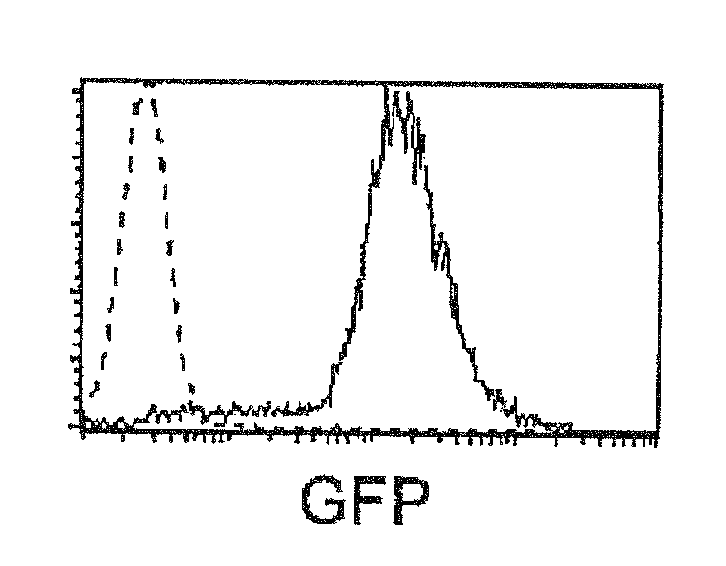Method for detection of human precursor t cell and precursor b cell
a technology of human hematopoietic stem/precursor cells and detection methods, which is applied in the direction of instruments, immunological disorders, extracellular fluid disorders, etc., can solve the problems of insufficient detection and quantification of human b cells and precursor t cells contained in a transplantation source, and the b-cell lineage has not been established
- Summary
- Abstract
- Description
- Claims
- Application Information
AI Technical Summary
Benefits of technology
Problems solved by technology
Method used
Image
Examples
example 1
Establishment of Stromal Cell Line
[0049]TSt-4 derived from the thymus gland of a mouse, which had been established by Watanabe et al. (reference), was used. Culture of TSt-4 was performed using, as a complete medium, RPMI 1640 (Sigma-Aldrich, St. Louis, Mo.) supplemented with 5% fetal bovine serum (FBS; Lot. 511042; BioSource International Camarillo, Calif.), 1 mM sodium pyruvate (Wako Pure Chemical Industries, Osaka, Japan), 1 mM non-essential amino acid solution (Invitrogen), 5×10−5 M 2-mercaptoethanol (2-ME; NACARAI TESQUE, Osaka, Japan), 100 μg / mL streptomycin, and 100 U / mL penicillin.
[0050]Dll1 was introduced into TSt-4 using a retrovirus vector pMSCV-IRES-EGFP (MIE vector) (from Dr. Nagahiro Minato, Kyoto University) (pMSCV-Dll-1-IRES-EGFP), to thereby yield TSt-4 / mDll1. The sequence of the introduced Dll1 gene is described in SEQ ID NO: 1 in the sequence list. Meanwhile, in the same way as above, DLL1 was introduced (pMSCV-DLL1-IRES-EGFP), to thereby yield TSt-4 / hDLL1. The se...
example 2
Detection Method of Human Precursor T Cell
[0061]Precursor cells capable of differentiating into myeloid or erythrocyte lineage can be subjected to a clonal assay using CFU-C of cord blood monocytes without further treatment (hereinafter, referred to as CBMNCs), and the number of the cells can be determined with the assay. If hematopoietic stem / precursor cells capable of differentiating into T-cell lineage can be detected with CBMNCs to quantify the cells, it is possible to previously examine the T-cell producing ability of CB to be used.
[0062]Therefore, in the present invention, in order to detect precursor T cells contained in a transplantation source such as CB, TSt-4 / hDLL1 established in the present invention was cocultured with CBMNCs to induce differentiation of precursor T cells contained in the CBMNCs into T cells.
[0063]In the coculture, TSt-4 / hDLL1 inhibited the appearance of CD19+ B cells from human hematopoietic precursor cells and induced differentiation of precursor T ce...
example 3
Detection and Quantification of Precursor T Cell Contained in CD34+CD38−Lin− Cell
[0071]1. Coculture of CD34+CD38−Lin− Cell with TSt-4 / hDLL1
[0072]CD34+CD38−Lin− cells were cocultured with TSt-4 / hDLL1 by the limiting dilution method. For comparison, CD34+CD38−Lin− cells were cocultured with TSt-4. 4 days before the beginning of culture, TSt-4 or TSt-4 / hDLL1 was inoculated with the complete medium into each well of a 48-well plate. CD34+CD38−Lin− cells were rapidly thawed and washed, and the obtained cells were subjected to limiting dilution and inoculated on each confluent stromal cell line. The cells were cultured at 37° C. and 5% CO2 for about 33 days, and the medium was exchanged every one week in the culture period.
2. Analysis of Cell after Culture
[0073]After the culture, the resultant cells were analyzed by flow cytometry.
[0074]The cells where differentiation was induced by the coculture were scraped off from the plate together with the stromal cell lines and subjected to FcR blo...
PUM
 Login to View More
Login to View More Abstract
Description
Claims
Application Information
 Login to View More
Login to View More - R&D
- Intellectual Property
- Life Sciences
- Materials
- Tech Scout
- Unparalleled Data Quality
- Higher Quality Content
- 60% Fewer Hallucinations
Browse by: Latest US Patents, China's latest patents, Technical Efficacy Thesaurus, Application Domain, Technology Topic, Popular Technical Reports.
© 2025 PatSnap. All rights reserved.Legal|Privacy policy|Modern Slavery Act Transparency Statement|Sitemap|About US| Contact US: help@patsnap.com



